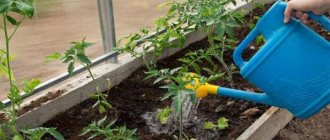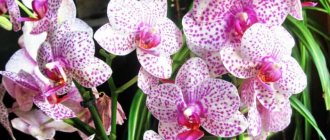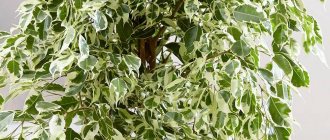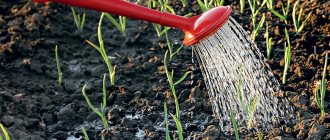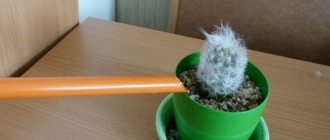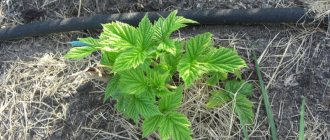Basic rules for growing and caring for dracaena
Although Dracaena is a tropical plant, it is quite unpretentious for indoor keeping. Loves warmth, moderate humidity and regular, but not too much watering.
Such conditions are quite easy to organize in an apartment, since home cultivation, regardless of the time of year, allows you to create the necessary air temperature for the palm tree.
Dracaena will grow healthy and beautiful if you follow the following rules in caring for it:
- The air should be warm. Temperatures in summer range from +20 to +25 °C; for a short time, the dragon tree can withstand higher temperatures. In winter, the temperature should not fall below +15 °C.
- The false palm tree requires a lot of light, but it is afraid of direct sunlight, and even dies in the shade. It is best to place a pot with dracaena on a window facing east or west; it can also be placed near the south window. Light likes abundant, but diffused. In winter, it needs additional lighting, since the winter sun is not enough for it.
- The plant is unpretentious to the soil and can grow in any soil. However, it will feel best in loose, well-permeable soil with drainage.
- The dragon tree only needs feeding during the growing season, which lasts from April to August. At this time, it needs to be fed with complex mineral liquid fertilizers once every 2 weeks.
- It needs replanting on average once every 3 years. Young individuals can be replanted once a year, and adults - once every 5 years.
- Almost all types of dracaena need high air humidity , so you need to spray it as often as possible.
- Dracaena prefers regular watering and moist soil. However, an excess of moisture and its accumulation at the roots is dangerous for the plant - the root system rots, pests multiply, and the false palm dies. That’s why it’s better to add too little water than to have too much water.
Did you know? The sap of the dragon tree is nicknamed “dragon’s blood” because the initially clear liquid turns blood-red when exposed to air and is very reminiscent of blood.
Dracaena propagation
You can begin to engage in the process of propagation of this plant at any time of the year, but experts still advise doing it in the spring - it is at this time, with the awakening of all living things in nature, that our heroine’s active growth begins. Another significant advantage is that you do not have to maintain the required temperature. But if, of course, there is no time to wait for the season, then you can do this at any time - the main thing is to maintain an optimal temperature balance. There are several ways in which a new dracaena will be “born”. Reproduction at home is easy:
- seeds;
- layering;
- cuttings.
Each of them has its own characteristics of practical implementation, which require more detailed acquaintance.
Seeds
In any specialized store you can buy dracaena seed material. Reproduction will occur according to the following algorithm:
- First, the seeds are soaked in a special growth stimulator (it is better to choose Zircon) for about a day. In this case, it is better to maintain a temperature of 30 degrees.
- After processing, the material is planted in soil for palm plants. In this case, it is best to choose disposable tableware as a container.
- The planting needs to be watered and covered with polyethylene. After this, you need to cover it with plastic and place it in a warm place (but avoid direct sunlight).
Usually this method gives excellent results - the first shoots should appear after two months. Now it’s a matter of regular watering and monthly feeding of young shoots. When the plant reaches 5 cm in height, it can already be planted in a pot.
Layering: using apical shoots
This method helps to simultaneously regulate the height of the plant (not everyone wants it to reach several meters in small apartments) and obtain a “daughter” dracaena. You need to do this:
- Treat the knife with alcohol and trim the plant itself. The resulting stump should be 6-7 cm (less than that is undesirable - the plant will simply bend).
- You can put this top in a container with warm water (you can first put an activated carbon tablet there). It is better to change the water periodically. The first shoots should be expected after about 90 days, after which they can be planted in a permanent place.
- You can plant the cut shoot in the ground. In this case, it is best to remove a couple of lower leaves. First, the end of the plant can be dipped in Kornevin powder. Land for such planting should be taken with a high peat content (usually such information is on the packaging). As for the pot, it is better to stop at a small one, no more than nine centimeters deep.
Cuttings
The plant can also reproduce using stem shoots - this is important when the top has withered. To do this you need to do the following:
- Choose a healthy and elastic plant stem with a diameter of at least two centimeters.
- Divide it into pieces 5 to 20 centimeters long (it is best to cut along leaf scars - those places where leaves are attached to the stem).
- Root the resulting cutting.
Regarding the last point, there are two ways to choose:
- When vertical, the lower part of the resulting cut is immersed in the substrate to a depth of 3 centimeters. Be sure to sprinkle a layer of sand 6 centimeters thick on top (so as not to replant the cutting in the future).
- With the horizontal type of planting, the cuttings are laid on the surface of a moist substrate and lightly pressed into it.
In both cases, a certain air and soil temperature must be observed - it should not fall below 20°C and rise above 24°C. The difference here is that in the first case only roots will form, and in the second - shoots as well. And in order to maintain optimal humidity, the plant must be sprayed regularly. The first results should appear in a month.
How many times and how often should you water your dracaena?
Dracaena loves water, but excess moisture is dangerous for it.
The frequency of watering depends mainly on the time of year and air temperature. So, if the air in the room is warm (over +20 °C), then watering should be more frequent - 1-2 times a week. The faster the soil dries out, the more frequent watering should be, so in hot weather you may need to water the flower more than twice a week.
The main criterion indicating that it is time to water is the dryness of the top layer of soil. It should dry 2–3 cm deep, but no more. If the top layer of soil has dried out, become crumbly and does not stick to your fingers, then it’s time to give the dracaena water.
When building an irrigation scheme and determining the frequency and volume of liquid, you need to take into account the following conditions:
- if the top layer of soil dries out more often than once a week or by more than 3–5 cm, then watering needs to be done more frequently;
- if the top layer of soil has not dried out within a week, it means that you need to increase the intervals between waterings and, possibly, reduce the amount of water;
- If water accumulates in the flowerpot above the soil surface, it means that the volume of liquid must be reduced.
The frequency of watering largely depends on the air temperature - the higher it is, the more often you need to water the dracaena, and vice versa.
With the correct supply of liquid, the plant looks great - with a lush foliage and bright colors.
At home, such types of dracaena as bordered, dragon and fragrant are grown.
Systematic watering of dracaena in winter
The first transplant should be carried out immediately after purchasing the plant, after waiting 2 weeks. This period will help the indoor flower adapt to new and unusual living conditions.
- Transplanting dracaena begins with choosing a new container for the indoor plant. A ceramic pot with drainage holes is best suited for this purpose. Now a little about the size of the container itself. The pot should be chosen with a reserve so that the root system of the plant has room to grow. For example, for a plant 40 centimeters high, a pot with a diameter of 15 centimeters is suitable. In each subsequent transplant (it is recommended to do it once every 2 years), the dracaena pot should be 2-3 centimeters larger than its predecessor.
- Traditionally, as for many other plants, soil for dracaena can be purchased ready-made in a specialized store or made independently. Mix the necessary ingredients such as turf, leaf, compost and peat soil in the following proportion: 2:1:1:0.5.
- The next step is choosing a drainage system. For young dracaena, medium-sized expanded clay is suitable. For mature flowers, you can purchase the largest drainage size that will be available in the flower shop.
- The bottom of the pot should be treated with boiling water, and then a good layer of drainage should be laid.
- Carefully remove the plant from the transplant pot and check the roots for any putrefactive processes. If there are any infected with fungus or other disease, remove them immediately.
- Carefully place the plant in a new pot and cover it with soil. Make sure that no roots remain on the surface. The transplant is complete.
- natural state of the plant (rest or vegetation);
- soil quality and composition;
- containers for planting, in particular on volume;
- location in the room;
- humidity level in the room.
- Thrips. If you notice that silvery spots that are uncharacteristic of its natural color have appeared on the leaves of the dracaena, there is reason to think about a pest attack. Most likely, we are dealing with small black bugs or thrips. They love to live on dracaena leaves, slowly moving along them. They reliably “record” the results of their movements in the form of blurry silvery traces. Pests can be controlled using special traps or folk remedies. For example, treat the leaves of a plant with soapy water.
- Shield. The pest attacks the leaves and stems of the plant. The consequence of the action of such a pest is yellowing of the leaves of the plant, as well as a slowdown or complete cessation of the growth of the false palm tree. The consequences of exposure to scale insects can be the most depressing: the plant dies.
It is better to combat scale insects with the help of insecticides. A drug such as Actellik is perfect. It is best to treat a houseplant not indoors, but outdoors.If the scale infestation is insignificant, then you can first try to treat the plant with a soap solution. If this does not help, then use chemicals with complete confidence.
- Spider mite. This pest affects most indoor plants. The spider mite does not deprive the dracaena of its attention. Surprisingly, over a short period it can cause serious harm to the plant. Initially, the leaves of the false palm begin to turn yellow, then dry out. If you do not take action, you may lose the plant altogether. A common cause of the pest is too dry air in the room. In such a situation, the drug “Fufan” will help. In the future, you should adjust the humidity, watering schedule and spraying of plants.
In the summer months, especially on hot days, dracaena is watered quite often: once every 2 days. In this case, it is imperative to check the soil lump. It should be dry to a depth of 2-3 centimeters. If the weather changes, it rains, or the temperature drops sharply, it is better to postpone watering for 1-2 days.
A sure sign that your plant does not have enough moisture will be the wilting of the leaves of the indoor flower. Also, do not forget about regular spraying of false palm. This will not only prevent the process of dehydration of the plant, but also protect the leaves from possible burns if they are exposed to direct sunlight.
In the winter months, when the temperature outside the window is stably below zero, the dracaena is at rest. Accordingly, watering should be reduced several times. In this case, everything also depends on the drying out of the earthen coma. Traditionally, in winter, the false palm tree is watered once every 3-5 days.
It is very important to consider the location of the plant in the apartment. If the dracaena is located in close proximity to a central heating radiator, then watering should be done more often.
As we already clarified at the very beginning of the article, dracaena is an unpretentious plant. But this does not detract from the fact that the false palm requires constant care. Every day, spend at least a couple of minutes with your pet.
The appearance of pests is a consequence of improper care of the plant or infection of other indoor flowers adjacent to the dracaena. Most often, false palm suffers from invasion: thrips, scale insects and spider mites.
We suggest you read: Why tomatoes don’t turn red in the greenhouse: what to do to make them ripen faster, what to do if the tomatoes don’t pour well
The wonderful false palm or dracaena is not too demanding to care for. Do not forget to systematically water the plant, change the growing container as necessary, spray and fertilize the flower. Do not forget about the correct lighting for the plant. To avoid sunburn, the flower should be shaded from direct sunlight. And then the indoor plant will become a wonderful decoration for your home interior.
What water is best to use
Using tap water that has not undergone any treatment is undesirable. Tap water is too chlorinated and hard, and therefore not very suitable for indoor plants. In addition, it contains salts and metals that promote the growth of pathogenic bacteria in the pot.
Soft neutral water is best suited for dracaena:
- melting;
- boiled;
- settled;
- rain;
- purified.
However, the risk of using rainwater is that it may contain various pests that can make the plant sick.
The simplest and most economical option is to use settled water.
Important! Before watering, the water should stand for several hours to two days.
However, using water that has stood for too long and has already bloomed is unacceptable, since pathogenic fungi appear in it.
The water temperature for irrigation should be room temperature or warmer - from +21 ° C and above. Spraying should also be carried out only with warm water.
How to properly water dracaena at home
There are several ways to water dracaena, each of which has its own advantages and disadvantages. However, the dragon tree tolerates each of them well. For watering, you can use any method, depending on the preferences and needs of the plant.
Through the top
Such watering involves the use of a watering can and the flow of moisture through the top layer of soil.
It is carried out as follows:
- Place the flowerpot with dracaena on the pallet.
- Take a watering can with settled water at room temperature or warmer.
- Hold the spout of the watering can close to the surface of the soil and slowly pour out the liquid in a not too strong stream. The soil should not be washed away. Water should flow evenly.
- Stop watering immediately when liquid begins to accumulate in the pan below.
- Leave the plant to stand in the tray for about a quarter of an hour. During this time, the dracaena will draw the necessary liquid from the pan with its roots.
- After the time has passed, remove the pan and pour out the excess liquid.
This method of irrigation is simple to implement and is most widely used. However, it has one drawback - with this method of water supply, minerals are washed out of the soil too quickly, so the dragon tree will need constant feeding with mineral fertilizers.
The frequency of watering with a watering can through the top is regular. This may be the main method of watering.
Beautiful legend about dracaena
Many peoples of South and Central America sincerely believe in this legend and consider dracaena to be the “tree of happiness.”
In ancient times, one very brave, but not very noble and very poor warrior fell in love with the daughter of the highest ruler of the tribe. Enraged by the unprecedented insolence, the angry father stuck an ordinary stick into the ground, which was used to light a sacrificial fire, and exclaimed: “I will give my daughter to you as a wife only if in a week at least one green leaf appears on this stick.”
The young warrior honestly watered the “plant” for the allotted time, not hoping for a miracle. And imagine his surprise when, on the fourth day, a timid green leaf appeared on a stick, and the next day it was already a small plant with green leaves. The lovers got married and spent their entire lives thanking the wonderful Dracaena happiness tree for their love.
Caring for an unpretentious dracaena is not so difficult. The main thing to remember is a number of simple rules that will help extend the life of your indoor branch.
On a note! Depending on the conditions of maintenance and care, the lifespan of dracaena ranges from five to fifteen years.
Features of watering at different times of the year
Watering dracaena differs depending on the time of year.
So, in the summer, the dragon tree begins a period of active growth. At this time, the plant needs abundant and frequent watering; it draws water well and grows quickly.
Find out what to do if your dracaena drops its leaves.
The frequency of watering depends on the air temperature and humidity. The main thing is to focus on the condition of the soil. Sometimes watering may be necessary every 2-3 days, if the top layer of soil has time to dry out during this period.
Once a month, dracaena can be bathed in the shower or watered in a tray. It is necessary to spray it as often as possible, but avoiding the accumulation of drops in the axils of the leaves. It is also recommended to wipe the leaves with a soft, damp cloth. The water temperature in the summer months can be room temperature.
But in winter, watering is different. At this time of year, dracaena is at rest, vegetation processes are suspended, growth slows down, and it does not draw moisture very actively. In addition, the air temperature drops in winter, which causes moisture to remain in the pot longer. That is why watering in winter is less frequent - it can be once every one and a half to two weeks.
Important! In winter, only warm water is allowed! Dracaena is watered and sprayed with this water. Otherwise, when using cool water, the plant may catch a cold.
However, it happens that in winter the apartment becomes hot when the heating devices are on. Batteries and radiators dry out the air too much. For these reasons, the moisture in the pot evaporates faster, and the dracaena begins to suffer from too dry air.
If this is the situation, then you need to water the plant more often - as needed, but the amount of water should be less than in summer to avoid excess liquid and rotting of the roots.
In dry air conditions in winter, the dragon tree really needs additional spraying.
Features of the procedure in cold and warm seasons
Winter is considered a dormant period for most flora representatives. Active growth in tropical species is observed only in summer and spring. Watering dracaena in the cold is often related to the temperature in the room. It is standardly recommended to water the leaves weekly and remove dust from them using a regular damp cloth.
Note! In a hot room, the watering interval can be reduced. Once every three days the plant needs not only moisture, but also spraying.
Summer time is suitable for organizing intensive care, which means that you need to water daily. It is even recommended to bathe Dracaena in summer. Wide leaves absorb moisture well.
Combination of fertilizers and watering
Since this plant is limited to a small amount of soil, over time it completely draws all the beneficial minerals from the soil, causing it to become depleted. In addition, watering also contributes to the leaching of elements, so dracaena needs additional and regular feeding.
Most often, the plant is fed during watering with liquid mineral complex fertilizers. They are well suited for dracaena, although for specimens with variegated leaves it is better to use fertilizers “for variegated plants”.
We advise you to read what and how to feed indoor plants.
This fertilizer is simply added to the water for irrigation in the dosage indicated on the package and watered over the top of the dragon tree with a watering can.
Dracaena should be fed only during the growing season, which begins in March and lasts until the end of summer. At this time, the frequency of feeding is once every 2 weeks. There is no need to feed the plant in winter.
To apply fertilizers, it is best to choose the evening, since it is unacceptable to use fertilizers during the day, because the sun's rays can burn the plant. On cloudy days, you can fertilize early in the morning.
Signs of improper watering
Dracaena is very sensitive to watering and is sensitive to mistakes.
Signs of lack of moisture:
- the leaves droop and droop;
- the tips of the leaves become dry and yellowish;
- leaves begin to curl;
- individual leaves fall off;
- the brightness of the color fades.
Find out what other reasons why dracaena leaves turn yellow and dry.
Signs of excess moisture:
- the trunk softens;
- dark soft spots appear;
- rotting processes are noticeable;
- loss of leaf color;
- the leaves become excessively soft;
- The rhizome rots.
Usually, if there is a lack of moisture, the plant can still be saved if you gradually increase the frequency and volume of watering. But with an excess of water and rotting of the roots and trunk, dracaena most often dies. In this case, the most reasonable thing is to cut off the healthy top for propagation and throw away the diseased dragon tree.
Did you know? The oldest dracaena in the world grew in the city of La Orotava on the Canary Islands, its age exceeded 6 thousand years. However, in 1868 it was destroyed by a hurricane.
Helpful care tips
You can promote the beauty and health of dracaena, as well as avoid mistakes in care, by adhering to the following recommendations:
- Dracaena does not like shade and partial shade, but it also does not tolerate direct sunlight. She needs a lot of light, but it must be diffused.
- Water for the dragon tree can be taken from the water supply. After boiling, you need to slightly acidify it with apple cider vinegar.
- Adding oxalic acid to it will help soften the water for irrigation
- The ideal soil for dracaena consists of turf, peat, sand and leaf soil.
- The plant does not tolerate low temperatures and drafts. It may get sick - its leaves will curl and then completely fall off.
- In order to limit the upward growth of the dragon tree and promote the expansion of the crown , you simply need to cut off the top with the growing point.
- Rotting begins when there is waterlogging, hypothermia, excess salts in the soil, or the proliferation of pathogenic bacteria.
- Despite the fact that dracaena is not a palm tree, it perfectly absorbs not only complex mineral fertilizers, but also specialized fertilizers for palm trees.
- Yellowed leaf tips are not restored . They must be removed by cutting with sterile scissors.
- Periodic yellowing and falling of the lower leaves is a normal phenomenon for dracaena. Dry and falling leaves must be removed in time.
- If in the summer you take the flower to the balcony, where it will be provided with comprehensive lighting and access to fresh air, then growth will accelerate, the crown will develop thick, wide and uniform, and the color will become brighter.
Did you know? In ancient times, dracaena was considered half-plant, half-animal, since its juice is very similar to blood.
When the juice hardens, it becomes like glass. Healing properties were attributed to glass shards from “dragon’s blood”. Caring for dracaena is not too burdensome, although the plant does not allow itself to be forgotten. It needs to be watered and sprayed on time, monitor the temperature and humidity, otherwise if the rules of care are not followed, it will simply get sick, lose its aesthetic appeal, or even die. Watering plays an important role in the well-being of the dragon tree and should be timely and moderate.
